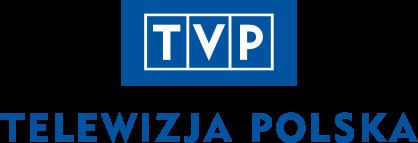Telewizja Polska S.A. (TVP S.A., or Polish Television) is a public broadcasting corporation, the only public TV broadcaster in the territory of the Republic of Poland. It is the largest Polish television network, with 13 national and 16 regional channels. About a third of TVP's income comes from a broadcast receiver licence, while the rest is covered by commercials and sponsorships.
1935 – The PIT (Państwowy Instytut Telekomunikacyjny - National Telecommunications Institute) starts working together with Polish Radio on establishing the first television service.1937 – Completion of a first black-and-white broadcasting station.1938 – Experimental channel launched, regular programming scheduled for 1941.1939 – All the equipment destroyed by the German Army.1947 – PIT resumes work on television broadcasting.1951 – First Polish telecast after the Second World War.1952 – Beginning of regular programming.1958 – Newscast Dziennik Telewizyjny was founded.1970 – TVP2 was founded.1971 – Start of colour broadcasting (in SECAM).1989 – Introduction of a teletext service.1989 – Dziennik Telewizyjny was replaced by Wiadomości.1992 – Telewizja Polska Spółka Akcyjna comes into existence upon the separation of television and radio public broadcasting by an act of parliament.1993 – Polskie Radio i Telewizja (Polish Radio and Television) joins European Broadcasting Union as an active member (regrouping of OIRT and UER).1995 – The start of moving from SECAM to PAL.2003 – Change of TVP logotype.2009 – New main headquarters building opened in Warsaw.2013 – Analogue terrestrial television was switched-offBolded channels are accessible in Poland via DVB-T. Other channels (except TVP Parlament) are satellite and (except Belsat TV and TVP Polonia) pay television.
General and regional channels
TVP1 - mostly news, current affairs, movies, dramas, and sports. Broadcasts 23.5 hours per day.TVP2 - mostly news, movies, comedy, soap operas, series, stand-up comedy, culture, sports and game shows. Broadcasts 23.5 hours per day.TVP3 - region-focused channel, which airs local programmes, and acts as the umbrella label for local stations including:TVP3 Białystok in Białystok for Podlaskie regionTVP3 Bydgoszcz in Bydgoszcz-Toruń for the Kuyavian-Pomeranian regionTVP3 Gdańsk in Trójmiasto for the Pomerania region,TVP3 Gorzów Wielkopolski in Gorzów Wielkopolski for Lubusz regionTVP3 Katowice in Katowice (Upper Silesian Metropolis) for Silesian regionTVP3 Kielce in Kielce for Holy Cross regionTVP3 Kraków for the Lesser Poland regionTVP3 Lublin for the Lublin regionTVP3 Łódź for the Łódź regionTVP3 Olsztyn for Warmia-Masuria regionTVP3 Opole for the Opole regionTVP3 Poznań for the Greater Poland regionTVP3 Rzeszów for the Subcarpathian regionTVP3 Szczecin for the West PomeraniaTVP3 Warszawa for Warsaw and the Masovia regionTVP3 Wrocław for the Lower Silesia regionTVP1 HD – HD version of TVP1, introduced June 1, 2012;TVP2 HD – HD version of TVP2, introduced June 1, 2012;TVP Info HD – HD version of TVP Info, introduced September 30, 2016;TVP HD – the best productions of TVP in HD, introduced August 6, 2008;TVP Sport HD – HD version of TVP Sport, introduced January 12, 2014.TVP Info – news channel. Broadcasts 24 hours per day.TVP Historia – focusing on history. Broadcasts 20 hours per day.TVP Kultura – high-brow culture channel, available on cable, satellite and DSL. Broadcasts 21 hours per day.TVP Polonia – retransmits selected TVP programming for the Polish diaspora (the so-called Polonia) in the USA, Canada, Latin America, Australia and New Zealand, South Africa, Europe, and the Caucasus. Broadcasts 24 hours per day.TVP Rozrywka – focusing on entertainment. Broadcasts 20 hours per day.TVP Seriale – focusing on series. Broadcasts 21 hours per dayTVP Sport – sport channel available on cable, satellite and DSL. Broadcasts 17 hours per day.TVP ABC – Children's channel. Broadcasts 15 hours per day.TVP Parlament – parliamentary channel. Broadcasts online.Non-Polish language broadcasting includes Belsat TV – channel in the Belarusian language presenting news and subject-specific programming for the people of Belarus. Broadcasts 16 hours per day.
TVP has an agreement with the BBC, under which they will work together in film and television productions.
The French-German TV liberal arts network ARTE cancelled a 15-year cooperation with TVP, when it learned in February 2009 that TVP's general director, Piotr Farfał, was a member of the League of Polish Families, which opposed Arte’s "philosophy based on intercultural exchange" and "the party that TVP's chairman is presently connected with does not share European values". It was again cancelled in January 2016 after an amendment of the media law in Poland, which caused fears of a lack of pluralism and independence of TVP.
1952–1992 - inscription TP.1992–2003 - Green letter T, red V, blue P, and the word TELEWIZJA POLSKA S.A. and three stripes: red, green and blue. In addition to letters three lines.2003–present - TVP logo and lettering TELEWIZJA POLSKA. 
